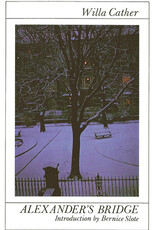Alexanders Bridge Bison
| Article number: | CATHER AB BISON |
| Availability: | In stock (11) |
When Alexander's Bridge appeared in 1912, it was described as "the story of a great engineer who has reached the crisis in his life when success and responsibility have begun to fret and weary a restless, energetic nature inherently impatient of restraint. Alexander tries to shake himself free, to go back to the time when life was at its highest, most adventurous pitch. The story is a love story, for it is in his relations with two women, Winifred, his wife, and Hilda, a young Irish actress, that Alexander learns to know himself. . . . It is a story of brilliant and unusual power." —McClure's Magazine
In the light of Willa Cather's later novels, Alexander's Bridge has long been regarded as uncharacteristic. In her introduction, however, Bernice Slote points out the themes, techniques, and details of Alexander's Bridge that tie the book to Cather's earlier and later work: Cather in fact was deeply engaged with her characteristic style and subject matter here. Slote considers the circumstances under which Cather wrote the novel and the events, people, and places from which she derived materials. She pays particular attention to Cather's use of myth and images and to the striking correspondences between Alexander's Bridge and The Professor's House.
Bernice Slote, a distinguished Cather scholar, was a professor of English at the University of Nebraska-Lincoln. Her publications included editions of April Twilights (1903); Poems of Willa Cather (1962, 1968); The Kingdom of Art: Willa Cather's First Principles and Critical Statements, 1893-1896 (1967); and Uncle Valentine and Other Stories: Willa Cather's Uncollected Short Fiction (1973, 1986), all published by the University of Nebraska Press.


